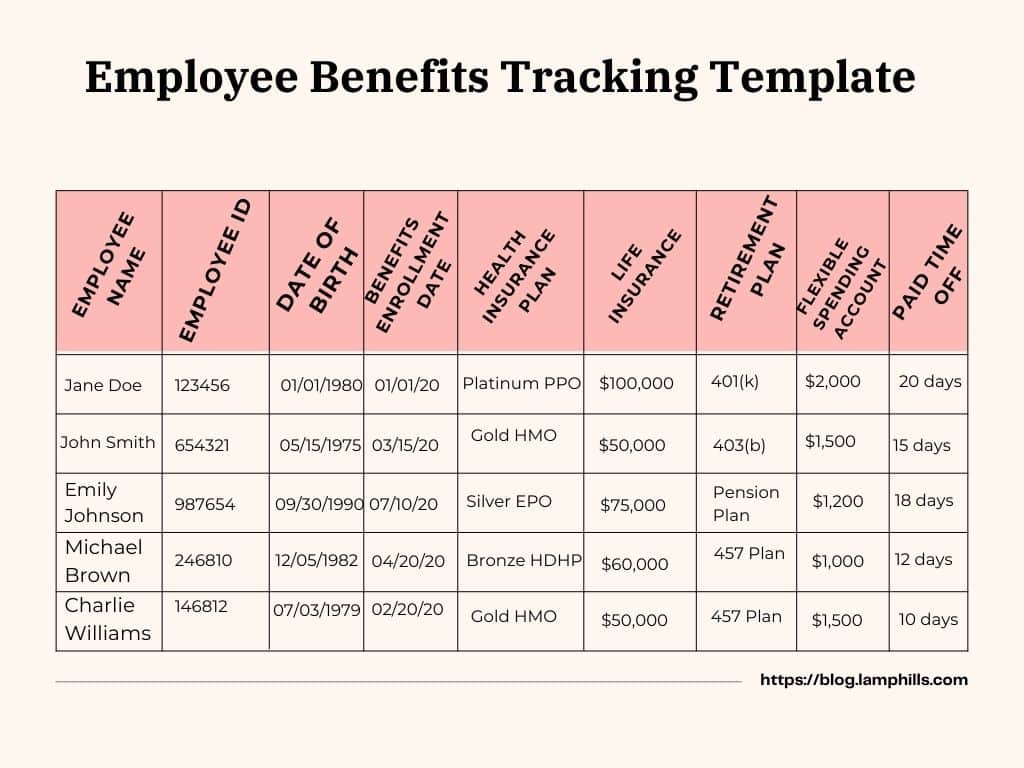Do you ever find yourself drowning in a sea of paperwork when it comes to managing employee benefits? Well, let me tell you, I’ve been there too. But fear not, because today I’m here to guide you through the wonderful world of creating and using an employee benefits tracking spreadsheet, including the template. Trust me, this tool is about to change the way you handle employee benefits. So, sit back and get ready to learn how to streamline and simplify your benefits management like never before!
Key Points
- Employee benefits tracking spreadsheet serves as a central tool to organize all employee benefits information in one place, making it easier to manage and update.
- Gathering employee benefits details through individual meetings ensures accuracy and allows for personalized assistance based on employee needs.
- Keeping the spreadsheet updated with changes such as new enrollments, benefit adjustments, and cost updates ensures all information is current and accurate.
- It enhances efficiency by providing quick access to comprehensive benefit details and promoting transparency between HR and employees.
- Even implementing security measures such as limiting access and password protection helps maintain confidentiality and protect sensitive employee information.
How To Create and Use an Employee Benefits Tracking Spreadsheet
Creating and using an employee benefits tracking spreadsheet can be a valuable tool for keeping all the important information organized in one place. It not only helps the HR department manage benefits efficiently but also enables employees to stay informed about their benefits.
Read Alos: 9 Effective Strategies for Workplace Success
Here are the steps to create and use an employee benefits tracking spreadsheet:
Step #1: Setting Up Your Spreadsheet
The first step in managing employee benefits data is setting up a spreadsheet. Whether you’re using Microsoft Excel, Google Sheets, or any other software of your choice, the process remains quite similar.
Start by creating columns to organize the information efficiently. You can include categories like employee name, employee ID, type of benefits (like health insurance or retirement plan), enrollment date, coverage details, premium costs, and any other relevant details that are important for tracking and managing employee benefits effectively.
This helps keep all the information in one place and makes it easier to update and analyze the data whenever needed. It’s all about ensuring that you have a clear overview of your employees’ benefits information at your fingertips.
Step #2: Gathering Employee Benefit Information
When it comes to gathering employee benefit information, I find that the most efficient way to do it is by setting up individual meetings with each employee. This allows for a personalized approach and ensures that I can gather all the necessary details accurately.
During these meetings, I usually confirm the start date of their benefits to ensure that there are no discrepancies. Then, I walk through the type of coverage they have, whether it’s health insurance, dental, vision, or any other specific benefits our company offers.
I make sure to ask about any dependents they have covered under their plan, as this information is crucial for the benefits package. Understanding who is included in the coverage helps in making informed decisions and providing the necessary support to the employees and their families.
Lastly, I always discuss the cost breakdown with the employees to ensure they are aware of any out-of-pocket expenses or contributions they need to make toward their benefits. You know transparency in this aspect is key to avoiding any misunderstandings later on.
Step #3: Inputting Data
Just like the saying goes, “Don’t put all your eggs in one basket”. When inputting data into the spreadsheet, make sure each employee has their row – separating and organizing the information neatly. After that, fill in the corresponding columns with their benefit details accurately, just like placing each egg in its designated spot.
Don’t forget to double-check for any discrepancies or errors. By following this methodical approach, you ensure that your data is well-organized and accurate, making the process smoother and more effective.
Step #4: Updating the Spreadsheet Regularly
Keeping the spreadsheet updated regularly is super important for managing employee benefits efficiently. For instance, you’ve just hired a new employee named Sarah who needs to be added to the health insurance plan. At the same time, another employee, John, has decided to opt out of the dental coverage. Also, there’s been an increase in the premium costs for vision insurance starting next month. How do you go about it?
Now, if you don’t update the spreadsheet to reflect these changes promptly, it can lead to confusion during open enrollment or when processing payroll. Sarah might not have access to the health benefits she’s entitled to, and John might still be deducted for dental coverage he no longer wants. Also, employees may be upset if they suddenly see a deduction for higher vision insurance costs without prior notice.
But if you update the spreadsheet regularly, you ensure that everyone’s benefits information is up-to-date and accurate. It will help in avoiding any confusion if outdated information is used for decision-making. So, whether it’s a new hire, termination, change in coverage, or updates in costs, keeping that spreadsheet current is key to smooth benefits administration and happy employees.
Step #5: Using the Spreadsheet Effectively
Using a benefits tracking spreadsheet can be helpful for both HR and employees alike. Think of it as your trusty friend in the world of benefits management. That’s it’s there to make everyone’s lives a whole lot easier.
For HR, having all benefit information neatly organized in one centralized spreadsheet is like having a treasure map that leads to smooth and efficient benefits administration. No more rummaging through endless folders or emails to find what you need. With just a few clicks, everything is right there at your fingertips. This not only saves time but also ensures accuracy and consistency in managing benefits for all employees.
And let’s not forget about the employees. Having access to this spreadsheet is like having a personal guide to understanding their benefits package. From coverage details to costs, everything they need to know is laid out clearly and concisely. Hence, it empowers them to decide about their benefits, giving them a sense of control and security over their healthcare and well-being.
Step #6: Ensuring Data Security and Confidentiality
For dealing with sensitive employee information in a spreadsheet, ensuring data security and confidentiality is absolutely crucial. Just imagine all those names, addresses, and other personal details floating around. You need to keep that information safe and sound.
One way to do this is by limiting access to the spreadsheet. Only authorized personnel should be able to view or make changes to the file. This helps minimize the risk of unauthorized individuals getting their hands on the data.
Another nifty trick is to consider password-protecting the file. Think of it as adding an extra layer of security – like putting a lock on a treasure chest. With a strong password in place, you can control who gets to open the file and keep prying eyes at bay.
By taking these simple but effective steps, you can ensure that the sensitive employee information in your spreadsheet stays protected and confidential. After all, we all deserve a little peace of mind when it comes to data security, right?
Step #7: Seeking Feedback and Making Improvements
Lastly, periodically seek feedback from HR staff and employees on the usability of the benefits tracking spreadsheet. Based on their input, make necessary improvements to enhance its effectiveness and ease of use.
After doing this, you can gather valuable insights into how the spreadsheet is working for them. Are there any confusing sections? Is the layout intuitive? Are there any features that are missing or could be improved?
Taking this feedback on board allows you to make necessary adjustments to the spreadsheet. Maybe you need to streamline certain processes, add more instructions, or adjust the formatting for better visibility. These tweaks can make a world of difference in enhancing the user experience and making the tracking process more efficient.
Don’t be afraid to reach out and ask for feedback. It’s through these conversations that you can truly understand how to make the benefits tracking spreadsheet a valuable tool for everyone involved. So, download the checklist below to get more information!
Employee Benefits Tracking Spreadsheet Checklist
Benefits Tracking Template
A benefits tracking template is a tool that helps you keep track of the positive outcomes or advantages that come from a particular project, initiative, or action. You can call it a handy checklist where you can note down all the good things happening as a result of your efforts.
Using a benefits tracking template can be super useful. This is because it allows you to see the progress and impact of your work in a visual way. It helps you stay organized, focused, and on track with your goals. Plus, having all the benefits laid out in front of you can be motivating and rewarding.
So, whether you’re working on a business project, a personal goal, or a team initiative, having a benefits tracking template can help you know the positive outcomes you’re achieving along the way. Also, it’s a great tool for tracking and celebrating your successes. Below is a sample of the employee benefits tracking template!
You Might Also Like to Read: How to Deal With Difficult Employees

Note: This table provides a basic template for tracking employee benefits information. Additional columns can be added as needed to track more specific details or types of benefits.
What Is A Benefits Tracker?
A benefits tracker is like your personal cheerleader for all the good things happening in your life. It’s a tool or system that helps you keep track of the positive outcomes and advantages you’ve experienced. Think of it as a way to monitor and celebrate the good stuff that comes your way, whether it’s reaching your fitness goals, completing a project at work, or simply feeling happier each day. Therefore, it’s a helpful tool to remind you of how awesome you’re doing and motivate you to keep striving for more wins.
How Do You Measure The Benefits?
When measuring benefits, think about what positive outcomes or advantages you are gaining from a particular situation or action. Consider factors like increased efficiency, cost savings, improved quality, and overall satisfaction. It’s important to track and assess these benefits to see the value of your efforts and make informed decisions for the future.
What Is An Employee Benefits Platform?
An employee benefits platform is like a one-stop shop for all the perks and rewards that come with a job. It’s where employees can access things like health insurance, retirement plans, paid time off, and maybe even discounts on gym memberships or shopping. Basically, it’s a way for employers to show appreciation for their hardworking staff by offering them a range of valuable benefits in one convenient place.
Related Articles
7 Affiliate Recruitment Tools for Finding the Perfect Affiliates for Your Brand
How Businesses Are Leveraging Geotracking for Enhanced Customer Experiences
Employee Branding in 2024: Top 9 Trends No Company Can Ignore (According to Experts)






